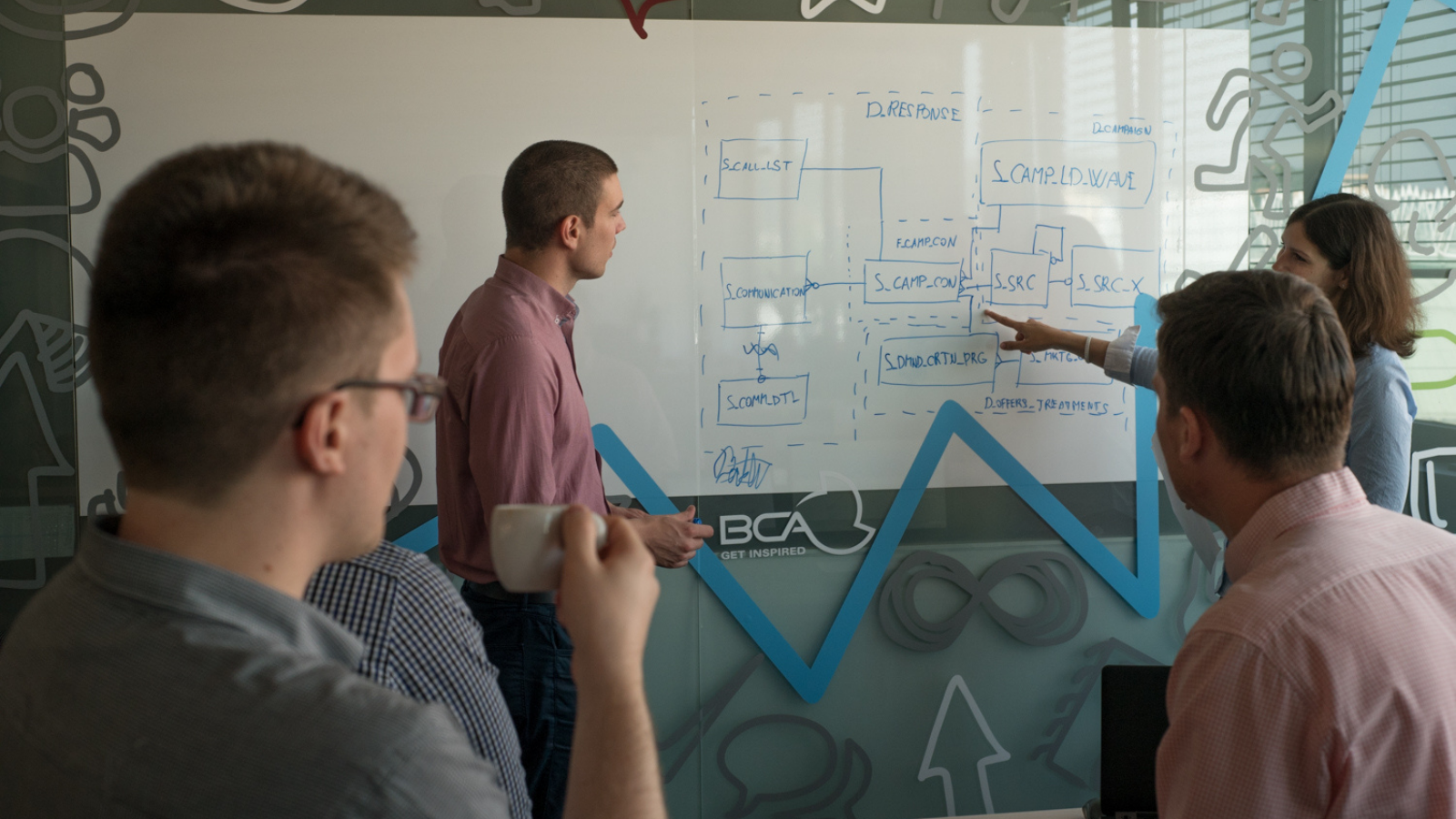Így néz ki az ideális RPA csapat

Kell egy csapat! - Egy RPA projekt sikere nagy mértékben függ attól, megvan-e hozzá a megfelelő csapatunk.
Kell egy csapat! – mára rengetegszer idézett szállóigévé vált a legendás mosodás, Minarik Ede kijelentése a Régi idők focija című filmből. Nagy meglepetést talán nem okozunk azzal, ha eláruljuk, hogy egy RPA projekt sikere is nagy mértékben függ attól, megvan-e hozzá a megfelelő csapatunk. Összeállításunkban azt mutatjuk be, hogy milyen „posztokra” kell találni valakit, ha szoftverrobotot szeretnénk alkalmazni.
Mivel nagyon változatos feladatokra és egyre többfajta cégnél vezetnek be szoftverrobotokat, az egyes RPA projektek között jókora különbségek lehetnek abban is, hogy mennyien dolgoznak az adott feladaton. Vannak viszont olyan szerepkörök, amelyek betöltéséről minden egyes RPA bevezetésnél gondoskodni kell, ha sikeres projekteket szeretnénk elérni.
A szoftverrobotok bevezetésének a kulcsfigurája az RPA COE (Centre of Excellence) vezető, aki lényegében az RPA operatív gazdája. Ő az a szervezeten belül, aki meglátja a lehetőséget az RPA-ban, elköteleződik a bevezetés iránt és a cégnél szószólója lesz a folyamatnak. A munkaidejének jelentős részében ezen dolgozik, meghatározza milyen megközelítés mentén és hogyan is kellene működnie a robotizálásnak, ha kell operatív szinten irányítja a folyamatot, meghatározza az üzleti célokat. Mondhatni, ő a projekt lelke, aki menedzsment és operatív feladatokat egyaránt ellát.
Ha kellően magas pozíciót tölt be a vállalatnál a COE vezető, akkor egyben a szoftverrobot bevezetés szponzora is lehet a cégnél, de sokkal jellemzőbb, hogy a felsővezetésben van még valaki, aki a kezdeményezés mögött áll. A szponzor ugyan többnyire nem vesz részt az RPA projekt operatív részében, de hisz a fejlesztésben, támogatja azt a menedzsmenten belül. A menedzsment megnyerésében a megoldásszállító is támogathatja a COE-t, hiszen a korábbi tapasztalatai alapján hatékonyan tudja bemutatni, milyen előnyökkel jár a folyamatok optimalizálása, a hibák csökkentése, az emberi tevékenység kiváltása, illetve, hogy milyen megtérüléssel lehet számolni.
Amikor egy cégnél már megvan a nyitottság és a kellő támogatottság is, akkor jöhet a következő lépés, vagyis annak kiderítése, hogy technikailag megvalósítható-e, és ha igen, milyen eredményekkel vezethetőek be a társaságnál a szoftverrobotok. Ezt a célt szolgálja a POC (Proof of Concept), amelyhez már újabb szereplők bevonására van szükség. Közéjük tartozik az RPA Business Analyst / Üzleti elemző, aki felméri az automatizálandó üzleti folyamatot, dokumentálja, illetve a szoftverrobot működéséhez alkalmazkodva átalakítja, finom hangolja azt. Természetesen szükség van egy RPA fejlesztőre is, aki technikailag megtervezi, megalkotja és az Üzleti elemzővel karöltve leteszteli a szoftverrobotot.
A BCA-ban az RPA Fejlesztő és az Üzleti elemző szerepkörök általában nem válnak külön, mert ez növeli hatékonyságot mind a megvalósítás, mind az elkészült automatizálás tekintetében: a folyamat felmérése és elemzése közben a kolléga már megvalósító fejjel is gondolkodik, illetve kódolás, konfigurálás közben, ha előjön egy újabb kérdés, hatékonyabb megoldás születhet, ha a fejlesztő részletesen ismeri az üzleti kihívást is.
A sikeres PoC után, ha a cég az automatizált folyamat éles rendszerben történő használata mellett dönt, akkor gondoskodni kell arról, hogy legyen, aki folyamatos támogatást biztosít a szoftverrobot működéséhez. Ők lesznek a Service Analyst / Támogató csapat, aki(k)nek a feladataik közé tartozik többek között, hogy beavatkozzanak, ha valamilyen okból leáll a szoftverrobot, illetve ha nem tudják a hibát orvosolni, bevonják a BA-t és/vagy a Fejlesztőt a kivizsgálásba. Ez a szerepkör gyakran folyamatos rendelkezésreállást igényel, hiszen akár éjjel, vagy hétvégén is bekövetkezhet probléma, amire reagálni kell.
Ha az első RPA projekt sikeresnek bizonyul és egy cégnél és úgy döntenek, továbbmennek az automatizáció útján, az automatizálandó folyamatok bővülésével érdemes újabb tagokkal bővíteni a csapatot. A robotok számának növelésével egyre markánsabb szerep jut az RPA Solution Architectnek, aki azon őrködik, hogy a teljes robotizált megoldás szervesen illeszkedjen az IT és üzleti folyamat logikájába, hatékonyan támogassa a vállalat célkitűzéseit, valamint hosszútávon költséghatékonyan üzemeltethető legyen. Ahogy halad az RPA bevezetés, egyre több folyamatot automatizálnak és sorra érkeznek az új igények, szükségessé válik egy Projektvezető kijelölése is.
Bár már az első bevezetés kapcsán is vannak az IT infrastruktúrával kapcsolatos tennivalók, ezeket kezdetben jellemzően még a vállalat informatikai részlege kezeli le. Viszont ahogy egyre több robotot alkalmaznak, nő a rendszer komplexitása, az infrastruktúrával kapcsolatos feladatok is bővülnek, így idővel szükség lehet dedikált RPA infrastruktúra mérnökre.
Szintén szükség van egy Supervisorra, aki a szoftverrobot licenckezelését végzi, illetve menedzseli azt is, mikor, melyik folyamat fusson az egyes robotokon. A teljes projekten belül ez viszonylag szűk feladatkör, ezért a gyakorlatban jellemzően valamely COE kolléga látja el ezt a szerepkört is.
Mivel a szoftverrobotok bevezetése az adott cég működésében, szervezetében is változásokkal jár, ezeket kommunikálni, menedzselni kell a munkatársak és a vezetés felé is, ami az RPA változás menedzser feladata.
